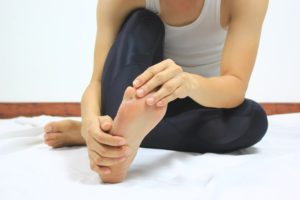
There are many different reasons for toe cramps, and uncovering the reason can help you prevent future toe cramping and reduce the pain and cramping. Here are 12 common causes of toe cramping.
12 Causes of Toe Cramping
Tight or weak muscles: There are dozens of tiny muscles within the foot and toe that allow for the toes to move. As with any muscle, they can spasm or cramp if they become weak or tight. Common causes of this include performing new exercises, wearing ill-fitted shoes, a sedentary lifestyle, and not stretching before exercises.
Muscle injuries: Common causes of injuries include overexertion, a fall or blow to the foot/toe, or over-extending a muscle tendon.
Poorly fitting shoes: Shoes that do not give your toes room or shoes that are the incorrect size can lead to cramping.
Dehydration: Dehydration contributes to toe cramping more so if there is a present injury or if you’re wearing ill-fitting shoes. Being hydrated helps ensure proper blood circulation and without proper circulation, muscles can cramp.
Electrolyte imbalance: Dehydration or overly sweating can lead to an electrolyte imbalance. In some cases, an electrolyte imbalance can be caused by a medical condition.
Restless leg syndrome: Restless leg syndrome can lead to nighttime foot and leg cramps, bizarre sensations within the legs, or cause a need to move around. This can make it difficult for a person to get a good night’s sleep. The underlying cause of restless leg syndrome isn’t well understood, so there is no cure, but there may be effective treatments you can try by speaking to your doctor.
Nerve damage: Damaged nerves can lead to tingling, pain, and cramps. A common cause of nerve damaged is uncontrolled diabetes.
Poor blood flow: Lack of blood circulation to the muscles in the foot and toes can lead to cramping.
Arthritis: Joints affected by arthritis become inflamed and painful. Some people suggest that joint pain in arthritis feels like muscle cramping.
Dystonia: Dystonia refers to the symptoms of involuntary contractions or spasms of the muscles. Diseases which can trigger dystonia include Wilson’s disease, multiple sclerosis, brain injuries, or even a stroke.
Organ failure: Organ failure can trigger an electrolyte imbalance along with making it difficult for the body to absorb nutrients which are necessary in all functions, including preventing muscle cramps.
Rare infections: In rarer instances infections can harm the muscles and nervous system to cause muscle cramps.
To narrow in on the exact cause of your toe cramps, it’s important to pay attention to other symptoms you may be experiencing and speak to your doctor to run diagnostic tests.
Remedies for Toe Cramping
Once you have uncovered the possible reason for your toe cramping, you can start to treat the problem with some toe cramp remedies.
Stretch toes: Often, regular stretching exercises can help to avoid toe cramps. Try standing on tiptoes to stretch the muscles in the foot, or try a marble pickup exercise. The marble pickup exercise is simply done by placing marbles on the ground and picking up each one at a time with your toes.
Use heat or ice: Applying a heating pad or warm towel to a cramped toe can help to relax muscles. Soaking your foot in warm water will also help the muscles relax. Ice can help with the pain associated with toe cramps. Gently massage your toe using an ice pack or some ice wrapped in a towel. Never put ice directly on skin.
Up your electrolyte intake: In some situations, such as when dehydrated or sweating, your body releases minerals and salt. Medications such as diuretics can also cause your body to lose minerals. Try giving your body a boost after a workout by snacking on a banana or some almonds. Yogurt, cheese, and low-fat milk are also a good source of minerals that your body may be craving.
Change your shoes: Women especially love to wear shoes that could potentially cause toe cramps. Spending an entire day in high heels can increase your risk for toe cramps as they can confine the toes and put pressure on the ball of the foot. Look for shoes that have a wider fit and toss your heels if they are causing discomfort.
Preventing Toe Cramps
To help reduce the risk of toe cramps, there are a few prevention tips that can be easily followed.
Keep physically active: Many people who lead a sedentary lifestyle are more at risk for toe cramps. Those who work sitting in an office should make a point to take frequent breaks and go for a walk.
Wear supportive, well-fitting shoes: There are many types of orthotic shoes for those who need more support when walking. Whether wearing shoes just to go for a walk, or to play a sport, there are special shoes designed for better comfort and foot support.
Stretch muscles: Be sure to stretch muscles in toes and feet every day. A great way to help stretch the body is through yoga or Pilates. Many people overlook the importance of stretching an only focus on steady exercise. Be sure to take some time to slow down and stretch.
Treat underlying medical condition: Talk to your doctor about making some lifestyle changes for a healthier body. Also, make sure to always take the medication exactly as prescribed by a doctor.
There are so many health benefits of getting up and walking more. It will not only reduce your risk of toe cramps but will benefit your overall health. Along with walking, be sure to stretch and wear appropriate shoes that don’t constrict the toes. If you are still experiencing toe cramping after taking all the precautions and toe cramp remedies don’t seem to be working, check with a doctor for any underlying causes.
Also read: Big toe joint pain: Causes, types, and pain relief tips